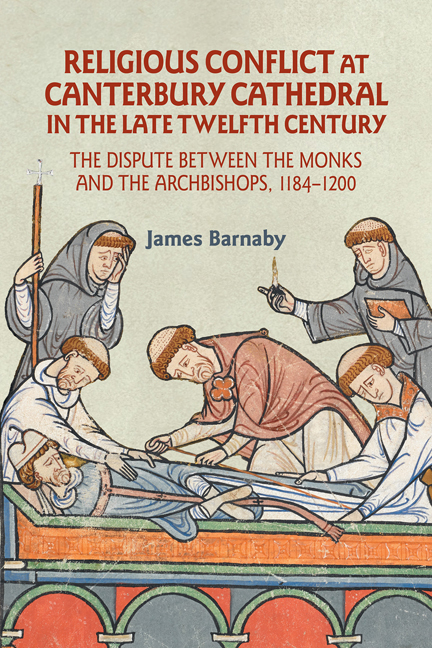 Religious Conflict at Canterbury Cathedral in the Late Twelfth Century
Religious Conflict at Canterbury Cathedral in the Late Twelfth Century Book contents
- Frontmatter
- Dedication
- Contents
- List of Maps
- Acknowledgements
- List of Abbreviations
- Introduction
- 1 The Canterbury Dispute in the Sources
- 2 Baldwin's Grand Plan (1184–November 1186)
- 3 To Rome (November 1186–July 1187)
- 4 The Hackington Dispute (August 1187–September 1189)
- 5 A New King, A Crusading Archbishop, and A Temporary Peace (September 1189–August 1191)
- 6 A New Primate (1191–3)
- 7 The Dispute Renewed (1193–1200)
- 8 After Lambeth: The Dispute in Later Centuries
- Conclusion
- Appendices
- Timeline
- Select Bibliography
- Index
- Other volumes in Studies in the History of Medieval Religion
Appendix 1: - Biographical Register
Published online by Cambridge University Press: 09 May 2024
- Frontmatter
- Dedication
- Contents
- List of Maps
- Acknowledgements
- List of Abbreviations
- Introduction
- 1 The Canterbury Dispute in the Sources
- 2 Baldwin's Grand Plan (1184–November 1186)
- 3 To Rome (November 1186–July 1187)
- 4 The Hackington Dispute (August 1187–September 1189)
- 5 A New King, A Crusading Archbishop, and A Temporary Peace (September 1189–August 1191)
- 6 A New Primate (1191–3)
- 7 The Dispute Renewed (1193–1200)
- 8 After Lambeth: The Dispute in Later Centuries
- Conclusion
- Appendices
- Timeline
- Select Bibliography
- Index
- Other volumes in Studies in the History of Medieval Religion
Summary
Below are short biographies of the main individuals involved in the dispute from 1184–1200. Names have been taken from the Canterbury letters and Gervase's Chronica. Individuals not alive at the time of the dispute, such as Thomas Becket, have not been included. When an individual was both a cardinal and a pope during the period, he is to be found under his papal name. At the end of each entry there are references to additional sources about the person which have not been directly referred to in the text.
Aaron, Monk of Canterbury
Aaron's name first occurs in 1187, when he was sent with conventual letters to be delivered to Archbishop Baldwin (Ep. Cant., 67 (no.80)]. He appears several times as an envoy to negotiate with the archbishop or the king (ibid., 67 (no.80), 292 (no.307), 315–17 (no.329)). On at least one occasion, May 1189, Baldwin refused to accept Aaron as a negotiator for the convent, suggesting Aaron was a prominent instigator of the convent's intransigence (ibid., 292 (no.307)). According to Ralph of Coggeshall, Aaron appeared in November 1190, where he was acting as a confessor of the monks, and Baldwin made his confession to one of them shortly before his death. This suggests that Aaron made the trip to the Holy Land as part of Baldwin’ entourage (Coggeshall, Chronica, 1576; Greatrex, Biographical Register, 66).
Alan, Third Prior of Canterbury
Alan appears as the third prior in 1189. At the beginning of August, Archbishop Baldwin summoned Alan and the other conventual obedientiaries to demand the deposition of Subprior Geoffrey and John of Bremble (Ep. Cant., 298–300 (no.314)). He was left in charge of the community at Canterbury in August 1189 (after the death of Prior Honorius), when Subprior Geoffrey went abroad to continue the monks’ appeal against the archbishop. In September, Alan received a letter from the subprior exhorting him to stand firm in the face of the archbishop's schemes at Lambeth (ibid., 307–8 (no.323); Greatrex, Biographical Register, 70).
Alexander of Dover, Monk of Canterbury
Occurs 1187–9. In September 1187, Alexander was one of several monks who appeared before the king in Normandy to explain the convent's case against Baldwin, returning early to Canterbury due to illness (Ep. Cant., 94–6 (no.121)).
- Type
- Chapter
- Information
- Religious Conflict at Canterbury Cathedral in the Late Twelfth CenturyThe Dispute between the Monks and the Archbishops, 1184-1200, pp. 209 - 224Publisher: Boydell & BrewerPrint publication year: 2024
